Florida
2000
Tuesday, May 2nd
Up early but not too early this morning. Took the Sanibel
Causeway on my way to J N Ding Darling National Wildlife Refuge on Sanibel
Island. While driving on the causeway I saw some gulls and realized that I had
not seen any gulls at all on the trip so far. I couldn't identify these, but
thought that they were Laughing Gulls. I did recognize the Brown Pelicans that
soared alongside the road.
I arrived at the refuge at about 8 AM - it had been open for a little while.
The refuge is named after J N "Ding" Darling who was a political
cartoonist. However, he was also appointed the head of the US Biological Survey
which later became the US Fish and Wildlife Service by President Franklin D.
Roosevelt. He also created the Federal Duck
Stamp. Waterfowl hunters in the United States are required to purchase annual
Duck Stamps. The proceeds from the sale of these stamps are used to purchase
wetlands and other property for the benefit of wildlife. Purchasing a Duck Stamp
also gives birders (and others) access to Wildlife Refuges for a year. There is
a competition among artists every year for the design of the stamp. The winner
earns money from the sale of prints. People also collect the stamps.)
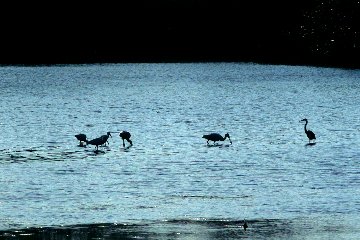 The refuge consists of a 4 mile drive with a few walking trails. The habitat
is varied - pools and estuaries, mangrove forests, and other stuff that I am not
sure of. It was definitely more varied than Shark Valley. The best time to visit
is when the tide is low and early morning when the birds are more active. At the
first area where I stopped, there were birds in the water on both sides of the
road. White Ibis were the most prevalent bird. Unfortunately, the birds on the
side with the sun behind them were the closest. It was hard to make out the
details or see the color of many of the birds. Some Roseate Spoonbills were on
both sides. I could make out the shape and some color of the close ones. The
colors on the other side were magnificent. A few took off and flew over me
giving splendid views. The "bad" side had a mud flat with a lot of
shorebirds on it. Black-bellied Plovers and Dunlin were mostly in breeding
plumage although some still lacked full color. I was able to see the plovers
pulling large worms from the sand. I had never actually seen the worms before. There was one Greater Yellowlegs and a
good number of Short-billed Dowitchers (identified by asking a park volunteer
which they were and being told that Long-billeds don't come to the refuge). Also
a few Least Sandpipers.
The refuge consists of a 4 mile drive with a few walking trails. The habitat
is varied - pools and estuaries, mangrove forests, and other stuff that I am not
sure of. It was definitely more varied than Shark Valley. The best time to visit
is when the tide is low and early morning when the birds are more active. At the
first area where I stopped, there were birds in the water on both sides of the
road. White Ibis were the most prevalent bird. Unfortunately, the birds on the
side with the sun behind them were the closest. It was hard to make out the
details or see the color of many of the birds. Some Roseate Spoonbills were on
both sides. I could make out the shape and some color of the close ones. The
colors on the other side were magnificent. A few took off and flew over me
giving splendid views. The "bad" side had a mud flat with a lot of
shorebirds on it. Black-bellied Plovers and Dunlin were mostly in breeding
plumage although some still lacked full color. I was able to see the plovers
pulling large worms from the sand. I had never actually seen the worms before. There was one Greater Yellowlegs and a
good number of Short-billed Dowitchers (identified by asking a park volunteer
which they were and being told that Long-billeds don't come to the refuge). Also
a few Least Sandpipers.
I enjoyed watching a Reddish Egret doing its hunting
dance. Lot of fun to see that. Several Willets were feeding on the other side.
Of course, I saw the other herons and egrets. A Red-shouldered Hawk's keer
attracted my attention and I easily found it. Not so easy was a Prairie Warbler.
I heard the bird calling and the park volunteers said that it was a nesting
Prairie Warbler. Despite its constant calling, I could not find it. I had been
to the refuge once before, in January 1992 and there were many more birds that
time. I guess the time of year has a lot to do with it. A little further along,
I was l able to get close to some of the birds
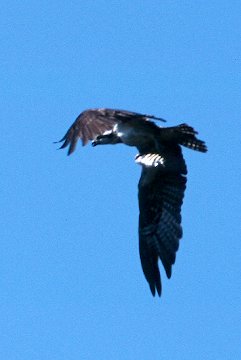
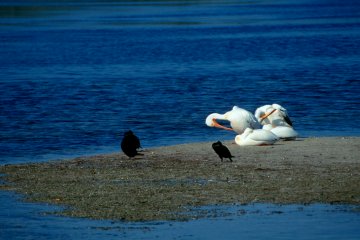 Drove on down the road and saw a Yellow-crowned Night-Heron on some mangrove
roots. Unfortunately, someone was taking pictures of it. I tried lining it up,
but there was foliage in the way. Finally, the other person left and I moved in
to take a great picture. I pushed the button and nothing happened. I had been
making adjustments to the camera and changed a setting. By the time I fixed it,
the bird disappeared. It was a really beautiful bird and would have made a great
picture. Heard the Prairie Warbler again but could not find it despite the
assistance of a woman who was also searching for it. We ran into each other
several times when we each stopped after hearing the bird, but searched in vain.
While looking for the warbler, an Osprey flew overhead carrying a large fish
with distinct black and white stripes. That was a nice sighting. Saw a few
American White Pelicans preening on an mudflat.
Drove on down the road and saw a Yellow-crowned Night-Heron on some mangrove
roots. Unfortunately, someone was taking pictures of it. I tried lining it up,
but there was foliage in the way. Finally, the other person left and I moved in
to take a great picture. I pushed the button and nothing happened. I had been
making adjustments to the camera and changed a setting. By the time I fixed it,
the bird disappeared. It was a really beautiful bird and would have made a great
picture. Heard the Prairie Warbler again but could not find it despite the
assistance of a woman who was also searching for it. We ran into each other
several times when we each stopped after hearing the bird, but searched in vain.
While looking for the warbler, an Osprey flew overhead carrying a large fish
with distinct black and white stripes. That was a nice sighting. Saw a few
American White Pelicans preening on an mudflat.
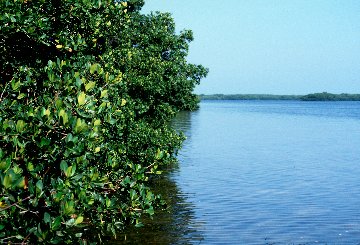 |
I walked along the Red Mangrove Forest Trail - not much in the way of birds
on the trail but the trees and their tall root systems are very interesting.
When I came out, the Prairie Warbler searching lady was there listening to, but
not seeing, the elusive quarry. She mentioned how tame the Red-bellied
Woodpeckers were while pointing to one a few feet from me. It was tame until I
raised my camera and then it flew away.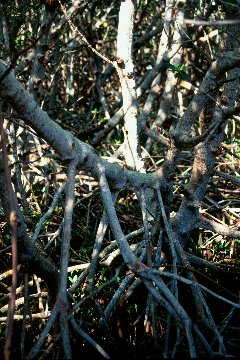 |
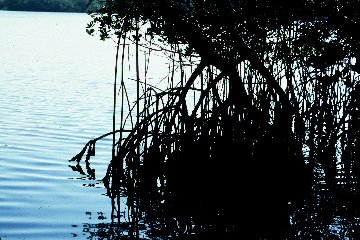 |
I saw another Osprey on a nesting platform. While watching it, I heard the
Prairie Warbler once more. I searched and searched and nothing. Then I saw a
small bird moving a distance away. I got closer. I continued to see movement but
could not really see the bird. I decided to try pishing and out it came. I was
able to get wonderful looks at this brightly colored little jewel for a couple
of minutes. When I ran into the woman a little later, she said she had seen one
(but not as well as I did).
We met up again near the exit. This time she was looking for a Mangrove
Cuckoo which she had been told was in that area. Again we could not locate the
target bird. She heard a "wheep" and asked if I knew what it was. I
said I thought it was a Great Crested Flycatcher and sure enough it was when I
was able to locate it.
The First Florida Page
More at Ding Darling NWR
 Go to the SongStar home page
Go to the SongStar home page
Drop me a note
Copyright © 2000 Richard L. Becker
 The refuge consists of a 4 mile drive with a few walking trails. The habitat
is varied - pools and estuaries, mangrove forests, and other stuff that I am not
sure of. It was definitely more varied than Shark Valley. The best time to visit
is when the tide is low and early morning when the birds are more active. At the
first area where I stopped, there were birds in the water on both sides of the
road. White Ibis were the most prevalent bird. Unfortunately, the birds on the
side with the sun behind them were the closest. It was hard to make out the
details or see the color of many of the birds. Some Roseate Spoonbills were on
both sides. I could make out the shape and some color of the close ones. The
colors on the other side were magnificent. A few took off and flew over me
giving splendid views. The "bad" side had a mud flat with a lot of
shorebirds on it. Black-bellied Plovers and Dunlin were mostly in breeding
plumage although some still lacked full color. I was able to see the plovers
pulling large worms from the sand. I had never actually seen the worms before. There was one Greater Yellowlegs and a
good number of Short-billed Dowitchers (identified by asking a park volunteer
which they were and being told that Long-billeds don't come to the refuge). Also
a few Least Sandpipers.
The refuge consists of a 4 mile drive with a few walking trails. The habitat
is varied - pools and estuaries, mangrove forests, and other stuff that I am not
sure of. It was definitely more varied than Shark Valley. The best time to visit
is when the tide is low and early morning when the birds are more active. At the
first area where I stopped, there were birds in the water on both sides of the
road. White Ibis were the most prevalent bird. Unfortunately, the birds on the
side with the sun behind them were the closest. It was hard to make out the
details or see the color of many of the birds. Some Roseate Spoonbills were on
both sides. I could make out the shape and some color of the close ones. The
colors on the other side were magnificent. A few took off and flew over me
giving splendid views. The "bad" side had a mud flat with a lot of
shorebirds on it. Black-bellied Plovers and Dunlin were mostly in breeding
plumage although some still lacked full color. I was able to see the plovers
pulling large worms from the sand. I had never actually seen the worms before. There was one Greater Yellowlegs and a
good number of Short-billed Dowitchers (identified by asking a park volunteer
which they were and being told that Long-billeds don't come to the refuge). Also
a few Least Sandpipers.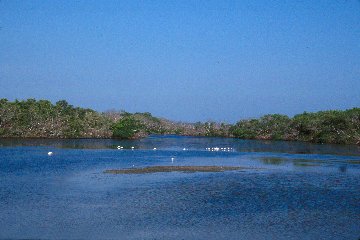
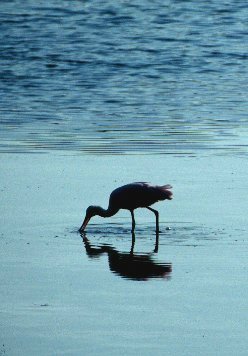
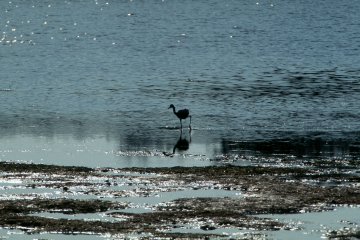
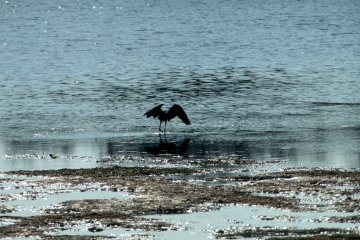
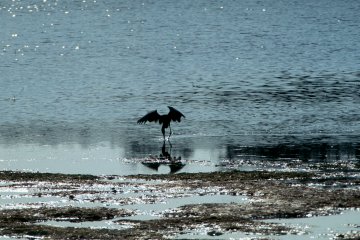
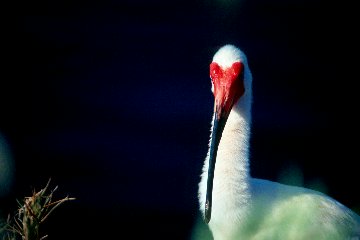
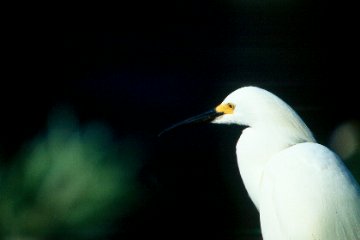

 Drove on down the road and saw a Yellow-crowned Night-Heron on some mangrove
roots. Unfortunately, someone was taking pictures of it. I tried lining it up,
but there was foliage in the way. Finally, the other person left and I moved in
to take a great picture. I pushed the button and nothing happened. I had been
making adjustments to the camera and changed a setting. By the time I fixed it,
the bird disappeared. It was a really beautiful bird and would have made a great
picture. Heard the Prairie Warbler again but could not find it despite the
assistance of a woman who was also searching for it. We ran into each other
several times when we each stopped after hearing the bird, but searched in vain.
While looking for the warbler, an Osprey flew overhead carrying a large fish
with distinct black and white stripes. That was a nice sighting. Saw a few
American White Pelicans preening on an mudflat.
Drove on down the road and saw a Yellow-crowned Night-Heron on some mangrove
roots. Unfortunately, someone was taking pictures of it. I tried lining it up,
but there was foliage in the way. Finally, the other person left and I moved in
to take a great picture. I pushed the button and nothing happened. I had been
making adjustments to the camera and changed a setting. By the time I fixed it,
the bird disappeared. It was a really beautiful bird and would have made a great
picture. Heard the Prairie Warbler again but could not find it despite the
assistance of a woman who was also searching for it. We ran into each other
several times when we each stopped after hearing the bird, but searched in vain.
While looking for the warbler, an Osprey flew overhead carrying a large fish
with distinct black and white stripes. That was a nice sighting. Saw a few
American White Pelicans preening on an mudflat.

